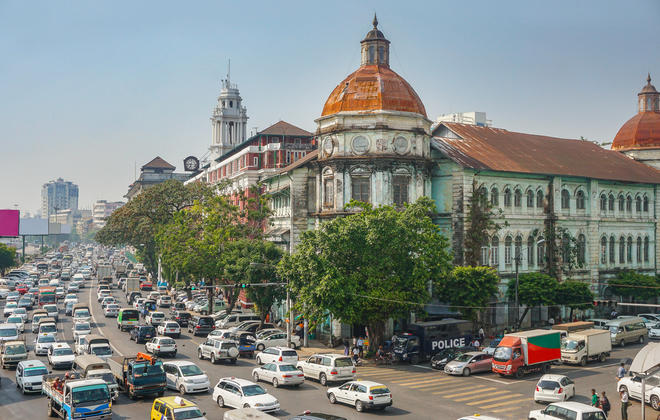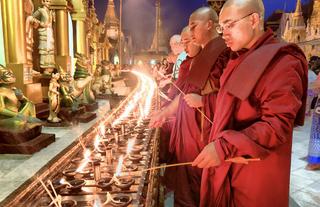Myanmar remains a land cloaked in mystery, where the path less travelled yields memories that linger for a lifetime. From the endless temple plains of Bagan, to the floating gardens and graceful fishermen of Inle Lake, to the pristine stretches of powdery sand along Ngapali, the country is a visual and cultural feast. Vast and diverse, roughly the size of France and England combined, Myanmar is home to more than 130 ethnic groups, each contributing to its extraordinary cultural mosaic. Stretching from snow-capped Himalayan peaks in the north to coral-fringed islands of the Andaman Sea in the south, Myanmar’s landscapes offer dramatic contrasts: fertile valleys, forested hills, serene rivers, and unspoilt coastlines. Ancient pagodas, royal palaces, and traditional villages pepper the terrain, offering a sense of timelessness and discovery. Whether seeking secluded beaches, cultural immersion, jungle adventures, or contemplative retreats among sacred temples, Myanmar presents an unrivalled opportunity to experience Southeast Asia in its purest and most authentic form—a country both enchanting and remarkably untouched.
The last royal capital of Myanmar. Mention of the word “Mandalay” conjures up sentiments of romance and tragedy, as immortalized in the literary gifts of George Orwell, Rudyard Kipling and Somerset Maugham. The true saga of the last reigning monarch King Thibaw, however, is imbued with romance and tragedy as much as any literary account. Through a combination of deceit, manipulation and false hopes stirred by court advisors and his wife, the fitful reign of King Thibaw ended when the British took Upper Burma in 1885. His family was exiled to India, where they lived in near poverty for the remainder of their lives. Before him, the struggles of the many ancient kings to gain control of the region were as complex and fantastical as a fairy tale.
With British rule, Mandalay’s streets were laid out on a grid system with the large, square palace compound of the former King Thibaw as its epicenter and surrounded by high, red walls and a moat. The effect is unlike any other city in Southeast Asia. With Myanmar’s highest concentration of monks, hundreds of monasteries, and legions of craftsmen, Mandalay is widely regarded as the religious and cultural heart of Myanmar. Among the most venerable pagodas are the Mahamuni Paya, now home to an ancient Buddha image from Rakhine State in western Myanmar, covered in gold leaf by devout Buddhists over many years; and Kuthodaw Paya, with 729 marble slabs bearing inscriptions of the entire Buddhist Tripitaka canon placed around the central stupa. According to legend, on a visit to Myanmar accompanied by his disciple Ananda, the Buddha climbed the 236 meter high Mandalay Hill overlooking the surrounding plains. Standing at the summit, he pointed with arm outstretched to where the Mandalay Palace stands today, and declared that a great city would be founded there after 2,400 years. That year corresponds to 1857 AD, when King Mindon ordered the move of the royal capital from Amarapura to a new city constructed at the foot of Mandalay Hill and bearing its name. Near the top of the hill, a standing Buddha image represents the prophecy.




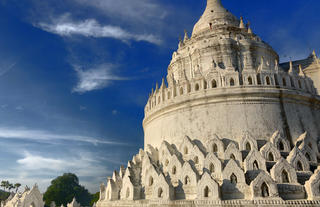
Thousands of temples, stupas and monuments in astounding shapes and sizes were built over two and a half centuries by the earliest Myanmar kings in the glorification of their religion. The monuments are packed in 40 km² (16 miles²) of land, rust colored plains flanked by the great Ayeyarwaddy River in heart of the country. Rival in scope and historical significance to the world heritage sites of Angkor Wat in Cambodia or Borobudur in Indonesia, Bagan is not to be missed. A visit here is undoubtedly one of the most memorable travel highlights in Myanmar.
The kings of Bagan
From the 11th to the 14th centuries, Bagan was the earliest unified seat of Buddhism in Myanmar. King Anawratha is credited as the founder in 1044 AD, using Buddhism as a tool to unite the people and sparking the royal building trend. Architects, artists, craftsmen and slaves were brought from nearby countries to create temples with walls as thick as a house, stupas covered in elaborate stone reliefs, and pagodas with intricate murals of the Buddha’s reincarnated lives.
The twelve kings following Anawratha would each try to outdo the last, the result being a spectacular legacy of religious monuments. Despite the tolls of weather and neglect, many structures have survived well to the current day. Mosaic artwork covers some buildings, gold leaf or carvings on others, and vines over crumbling stone facades on still more. Depending on how one defines and counts the structures, numbers range from 2,100 to 4,400 temples in the heart of the archaeological site. Lenient regulations mean visitors can still climb the staircases of the tallest stupas to enjoy views the temple-studded landscape in all its glory. Watching the sun illuminate the outlines of the ancient ruins in the mist of dawn or dusk is yet another breathtaking experience of Myanmar. It’s no surprise that Bagan remains one of the most fascinating archaeological sites in all of Southeast Asia. Bagan was once one of the most glorious Burmese kingdom with trading relations extending to the ancient empires of India, Ceylon and Khmer. Other Myanmar Kingdoms such as at Thaton in today’s southern Myanmar were overrun by Bagan, and their culture and manpower absorbed into the Bagan Kingdom. In the late 14th century, the Bagan Kingdom abruptly scattered to the winds, purportedly with the arrival of the Mongols under Ghengis Khan. Its monuments remain, however, and have defied the ravages of time and nature. The majestic vestiges of the kingdom are ranked by many today as one of the great wonders of the world.
Even the great Marco Polo made reference to Bagan in The Description of the World, the narrative of his two and a half decade long odyssey into the Orient and beyond: “The towers are built of fine stone, and one has been covered with gold a finger thick, so that the tower appears to be of solid gold. Another is covered with silver in a similar manner and appears to be made of solid silver…They make one of the finest sights in the world, being exquisitely finished, splendid and costly. When illuminated by the sun they are especially brilliant and can be seen from the great distance”.





Situated high up in the western Shan State, Kalaw is a former hill station founded by British civil servants. It is something of a high-altitude resort – cool, calm and leafy – but is also widely known as a trekking Mecca in Myanmar, as those wishing to explore the surrounds can do so without prior permission. Its population is diverse, as Nepali Gurkhas, Indian Hindus, Sikhs and Muslims came here to build the roads and railway line during the British period. A wide variety of exploring options are available, including three-day treks to Inle Lake or Pindaya. At the town’s heart is its market, where villagers from the surrounding areas come to sell their produce and an eclectic range of foods. Visit the Aung Chang stupa, or take a ride to the Green Hill Valley elephant camp, founded in 2011 to care for ageing and ailing elephants.
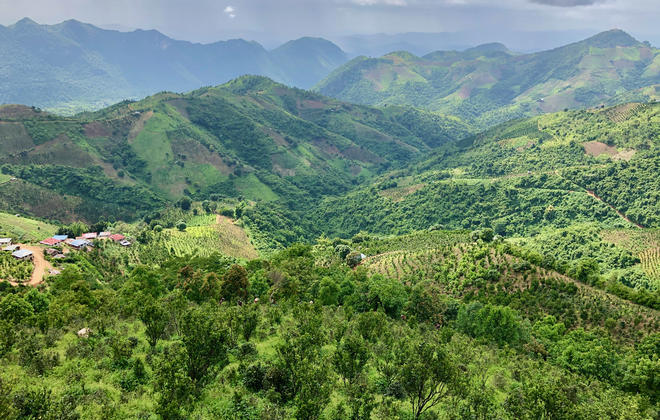


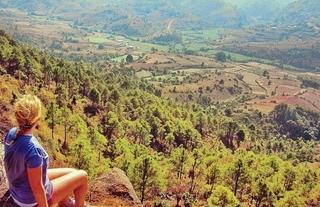
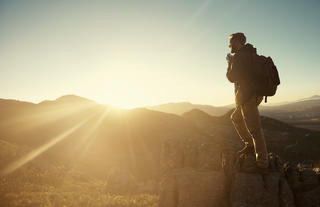
Hautingly picturesque, Inle Lake is one of Myanmar’s most iconic destinations in the mountains of Shan State, where floating gardens made of woven water hyacinth reeds, silt and bamboo provide a backdrop for graceful, one-legged boat rowers. Inle Lake is perfect for leisurely boat excursions, walking explorations or longer trekking trips through the villages of the Shan, Pa-O, Intha and Danu ethnic minority groups.
Inle Lake lies at an altitude of nearly 3,000 feet, fringed by tall grasses and reed beds, ringed by well-forested hills and, according to the season, may often be wreathed in mist. The main body of the lake is some 13 miles in length with calm, crystal clear waters. Its shores and floating islands are home to villages built on stilts, whose inhabitants are the hardworking and resourceful Intha people. These are the famous leg rowers, skillfully navigating the lake by rowing in a standing position – one leg wrapped around an oar pivoted on their hip, another leg balancing on the prow of their boat, and body poised to plunge a fish trap into the waters beneath. In addition to their fishing skills, the Intha are traditional market gardeners, cultivating flowers and vegetables on a floating tangle of water hyacinth and silt anchored to the lake bed by bamboo.
Moreover, Inle Lake is an official bird sanctuary, rich in wildlife. Its main body is reached along a narrow waterway from the northernmost lakeside town of Nyaungshwe. The boat ride passes waterside temples and villages, and in the less populated stretches, herons stand in solitary contemplation at the water’s edge while cormorants dive for their prey. In the principal part of the lake, there are many islands to visit. Away from these developed areas, a leisurely canoe paddle through channels branching from the lake brings a closer view of the local life, with fascinating encounters and friendly villagers. Heading south from the main body of the lake the traveller passes through another long and narrow waterway to reach the 17th century ruins of Samkar, where Shan and Pa-O villagers now live side by side, and the ancient Tharkong Pagoda, which legend tells was founded by an early Burmese king. The region offers ample trekking opportunities and extended walks to keep the active traveller busy. Trekking out into the Shan hills east of Nyaungshwe, at the lake’s northern end will lead to Pa-O villages and beautiful views of the lake along the way. Extended walks through rice paddies pass many Shan stupa ruins that lie dotted around the countryside.





With a population of over 5 million, Yangon, also known as Rangoon, was the capital of Myanmar up until the end of 2005. It remains the largest city, and is still the pivotal commercial hub of the country today. A visit to this magnificent city will allow you to take in the interesting mix of British, Burmese, Chinese and Indian cultures that mingle there. The skyline is an interesting contrast of decaying colonial architecture and modern high-rises, dominated by the golden glow of the Shwedagon Pagoda, an exquisite Buddhist temple that draws pilgrims from across the globe. Your time here would be well spent visiting the impressive array of temples, museums and markets that the city has to offer.
History Yangon in brief
European countries in a race to control trade routes had established trading posts in across South East Asia. East India Trading company controlled by the British had extended its operations to the Burmese coast and where trading with the Burmese kings. Three Anglo-Burmese wars flared up and in the second Anglo-Burmese war 1852 the British took over Southern Burma and made Rangoon its capital. The old name of Rangoon was Dagon. After third war in 1885 and ousting king Thibaw in Mandalay where the capital was located Rangoon became the capital for the whole country of Burma. Dr William Montgomerie sketched the new plan for the city and Lt Alexander Fraser from the Bengal Engineers implemented. Many architects were employed to fill in the city plan with schools, hospitals, parks, banks, shops and administrative buildings.
Fast forward… the colonial times are long gone, but in Yangon they have left behind a rich architectural heritage, of a type which many other capital cities of the region has been lost to “progress”. Yangon has the largest number of colonial buildings in the whole of Southeast Asia. Many colonial-era buildings that today host state institutions and authorities, such as government banks and the Port Authority, as well as the High Court and City Hall, are clustered in the downtown area. The Strand Hotel is there, too, built by the famous Sarkies Brothers in 1901, and today a sumptuous reminder of a bygone era.
Unlike many of its regional counterparts Yangon is also still first and foremost a green city, despite the battering it received from a cyclone in 2008. In the tranquil settings of Kandawgyi Lake and Inya Lake, and along its wide avenues, Yangon can still boast countless old trees and vegetation. A panoramic view of the city reveals its beauty – with the awe-inspiring Shwedagon Pagoda in its golden hue on one side, on a low hill, and on the other side the ancient Sule Pagoda and its encircling shops in the downtown area.
